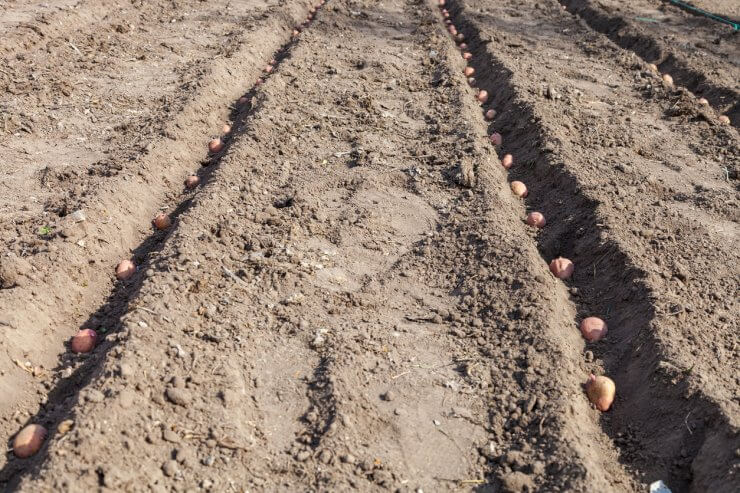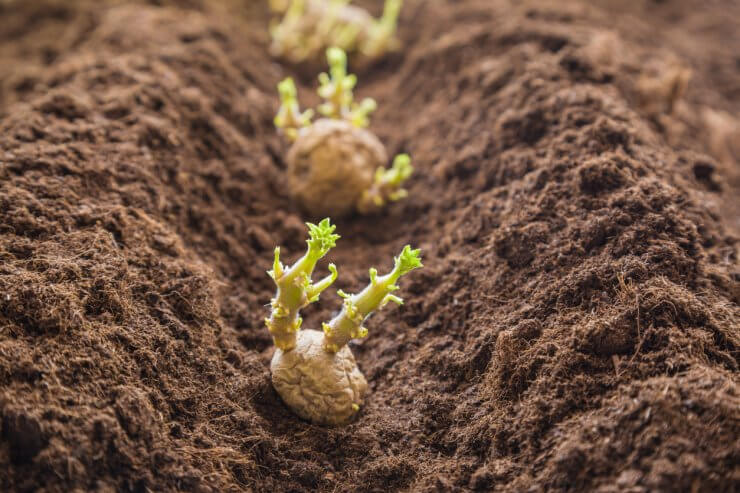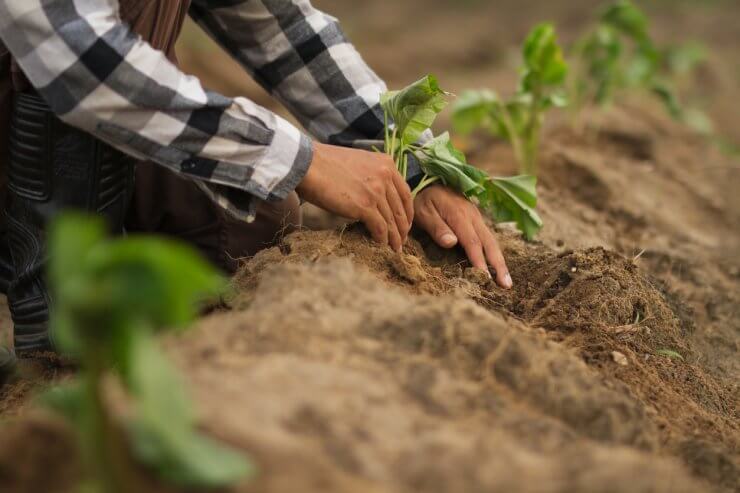
Digging a trench for planting potatoes
Potato

Planting potatoes
You can plant your potatoes up to two weeks before the last killing frost; the soil temperature should be at least 55 degrees F during the day and 45 degrees F at night. Plant your pieces 4 inches deep and about a foot apart. Space your rows 2 feet apart (potatoes spread out underground). Some gardeners recommend a 3-foot spacing. But if your rows are 2 feet apart, the potato foliage will help form a canopy between rows—and that discourages weed growth. If you’re planting a smaller variety, such as fingerling potatoes, you can plant the seeds and rows closer together.
Now comes the fun part. When your potato plants emerge from the soil, you’re going to begin the process of hilling. You can use soil, mulch, straw, or wood chips—the goal here is to make sure you protect the growing tubers from sunlight. Sunlight is essential for the stem and leaves of the potato plant, but potentially devastating for the tender tuber. If your potatoes are exposed to sunlight and start turning green, discard them (in the trash, not the compost). Remember when we talked about the poisonous alkaloid potatoes can develop? Yup, that’s it. (Is it any wonder it took so long for people to trust potatoes?)
As your potato plant grows, continue to hill up the soil around the base of the plant. This will keep moisture near the plant and will protect the tubers from sunlight.
An optional hilling method is to use straw. Plant your seed potatoes just an inch in the ground. When the shoot emerges, just pile straw around the base of the plant 4 to 6 inches deep around the plants and between the rows. The potatoes will form above the soil surface, but under the straw. The straw conserves moisture and keeps the soil cool. And come harvest time, all you have to do is pull the straw away to get to your potatoes!
Sweet Potato

Planting sweet potato slips in mounded row
Check your slips to make sure they’re ready for planting; they should be 6 to 8 inches long and have four to five leaves and a healthy root system. Make sure there’s no risk of frost. Plant your slips in about 2 inches of soil 3 to 4 feet apart, with about a foot between rows. Water gently. Cover with mulch to conserve moisture and deter weeds.
Ideally, your soil should be in mounded rows. This provides two benefits: it allows the soil to dry more quickly in the event of heavy rain or overwater, and it allows the soil to warm up more quickly.
Once your sweet potato plants start growing, watch for weeds and remove them (roots and all) as soon as possible so your young plants don’t have to compete for nutrients. Make sure they get about an inch of water a week.
Potato Companion Plants
Potatoes are the third-grade bully. They have problems with everybody! Cucumbers, melons, squash, turnips, all fall victim to the potato and its competition for nutrients and moisture. Even members of the potato family, like the tomato, shouldn’t be near the potato because they slow the growth of each other and can be more susceptible to potato blight (Phytophthora). Best to keep these veggies in the corner!
How do you plant your potatoes or sweet potatoes? Please tell us about your planting process.


 Previous
Previous

